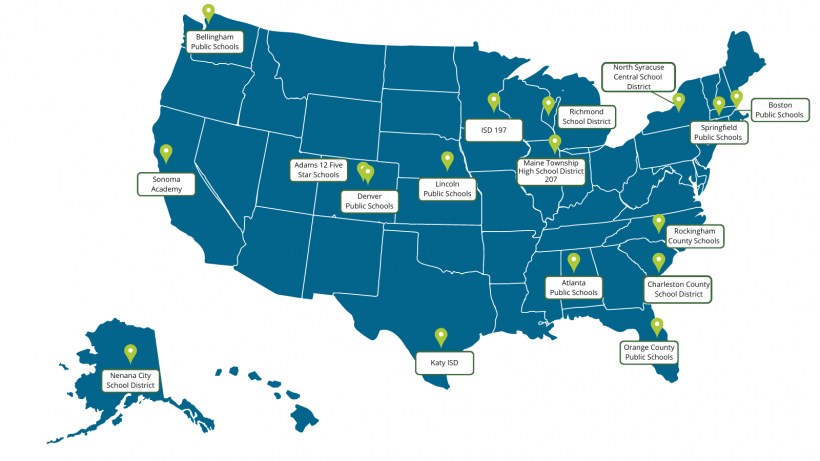
The U.S. Department of Energy’s (DOE’s) Efficient and Healthy Schools campaign recently celebrated the achievements of 17 K-12 schools and districts that implemented exemplary projects to improve the energy and environmental performance of their school’s facilities. Schools were honored for upgrading facilities with technologies and practices that create healthy and more sustainable learning environments for students and staff and slash their facilities’ energy needs, carbon emissions, and utility bills.

The Efficient and Healthy Schools Campaign, led by DOE’s Building Technologies Office, is an interagency effort supported by the Environmental Protection Agency and the Department of Education to recognize and provide technical assistance for school districts that seek to implement high-impact indoor air quality and efficiency improvements in their facilities. Now in its second year, the campaign began in 2021 when school districts across the country were forced to determine if their facilities’ ventilation systems could allow them to safely reopen their doors for in-person learning while an airborne virus, COVID-19, continued to circulate worldwide. DOE and its partners at Berkeley Lab realized this moment was a unique opportunity for schools — a chronically under-resourced segment of commercial buildings — to not only improve the indoor air quality of their facilities, but to upgrade their energy and environmental performance overall. The campaign set out to offer its assistance to schools and connect them with the practical solutions and means to implement them. 142 school districts in 44 states now receive this specialized assistance through the campaign, representing over 3.8 million students across more than 6,400 individual schools.
This [moment] is such an exciting inflection point for energy efficiency, indoor air quality, health, performance and sustainability that I haven’t seen in my 30-year career. Indoor air quality and energy efficiency have a critical relationship. They really are two sides of the same coin. You cannot have one without the other.
Tracy Enger, a program manager in EPA’s Indoor Environments Division
While K-12 facilities are the second-largest sector of public infrastructure spending after highways, many schools are in poor condition and struggle to improve and maintain key building systems that can impact school utility and maintenance costs, as well as teacher, student, and staff health. K-12 schools consume about 9% of all the energy used in commercial buildings, and energy consumption is the second highest operational expense schools face. A huge portion of this energy is lost through things like leaky school walls or windows, or other inefficient equipment and systems.
While noting this, DOE’s Acting Assistant Secretary for Energy Efficiency and Renewable Energy Alejandro Moreno echoed Enger’s sentiment, saying:
Of course upgrading buildings isn’t just about energy. Upgrading school facilities helps improve student health, optimizes spaces for learning, and we know that improved indoor air quality can alleviate respiratory illnesses, improve student and teacher attendance and performance, and decrease risk of transmission of respiratory infections like COVID-19. These projects improve the quality of the air our students and educators breathe while reducing energy costs and freeing up local funds to invest in education. If that’s not worth our money and our attention, I don’t know what would be.
Two-thirds of the schools operated by honorees receive assistance through the federal Title I program that supports low-income students throughout the nation, including schools from rural and urban areas that collectively serve over 600,000 students across 15 states. The 17 schools DOE recognized were honored across several categories of achievement, such as how well-planned and documented their building upgrades were and how effective those improvements were at not only creating healthy learning environments but sustainable ones that save energy, reduce emissions, or enhance resiliency in the face of extreme weather or power outages.
Thanks to leaders like you across the country, more students are feeling the benefits of improved air quality, clean and safe drinking water, and buildings that use efficient and renewable energy technologies. You know firsthand how important it is that your school communities are recognized and the impact that your story can have on inspiring other districts to take similar actions.
Andrea Falken, special advisor for Infrastructure and Sustainability at the U.S. Department of Education
The 2023 Efficient and Healthy School Honorees
- Adams 12 Five Star Schools in Colorado
- Atlanta Public Schools in Georgia
- Bellingham Public Schools in Washington
- Boston Public Schools in Massachusetts
- Charleston School District in South Carolina
- Denver Public Schools in Colorado
- ISD 197 (West St. Paul – Mendota Heights – Eagan Area Schools) in Minnesota
- Katy ISD in Texas
- Lincoln Public Schools in Nebraska
- Maine Township High School District 207 in Illinois
- Nenana County School District in Alaska
- North Syracuse Central School District in New York State
- Orange County Public Schools in Florida
- Richmond School District in Wisconsin
- Rockingham County Schools in North Carolina
- Springfield Public Schools in Massachusetts
- Sonoma Academy in California
To learn from honorees about their experiences in the campaign and their accomplishments, watch the recorded celebration and read more about each school’s projects on the 2023 Recognition Program Honorees webpage.
